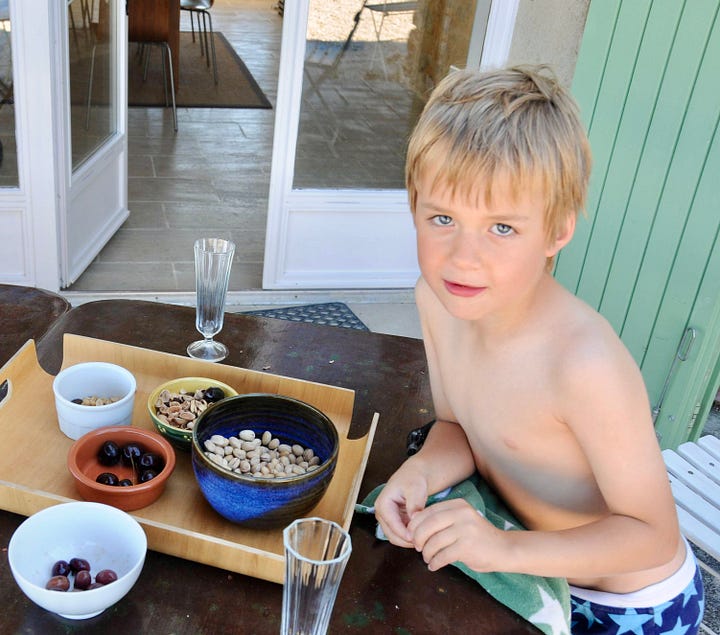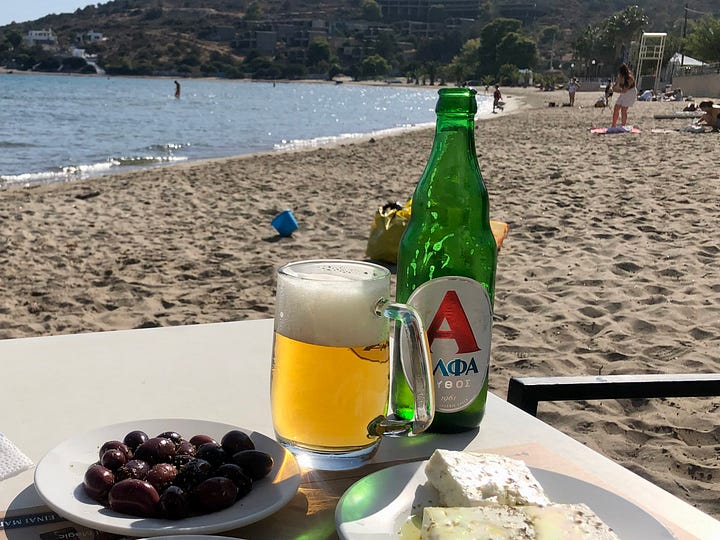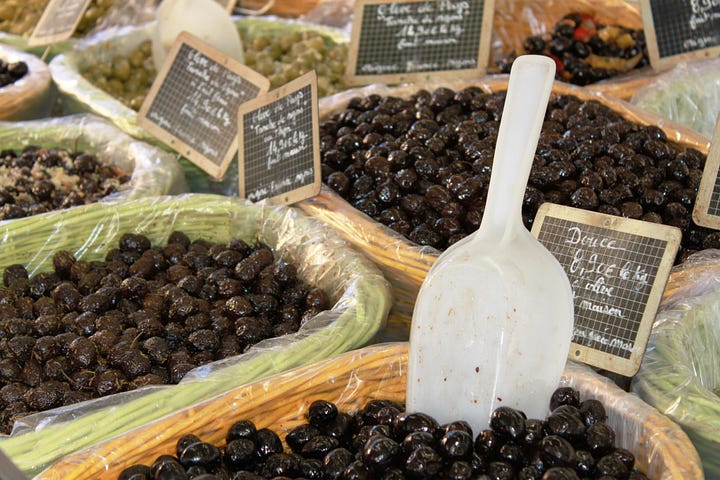Olives, my taste of freedom
Today you can buy the quintessential Mediterranean snack anywhere in Britain, but olives still taste to me of travel in the sun. Plus: what I've been drinking at Christmas




I’m on the road just now, so here are some thoughts on the key taste for me of a lifetime’s travel in the Mediterranean, and why a bowl of olives still makes me feel free. I’ll be back in more conventional mode next week.
It was a moment of pure freedom: bouncing along in the back of a farmer’s pick-up truck in the Languedoc, my backpack on the floor next to me, devouring a packet of black olives. I’ve always felt most free when lighting out with my possessions on my back: striding down the side of a new country road never fails to give me a thrilling sense of possibility. As I sat in the sunshine that day, relishing the salty olives as we traversed hairpins into the village of Minerve, I was elated.
Indeed at this time – the mid-1980s – olives remained something that could only rarely be enjoyed outside the Mediterranean. Growing up in the previous decade, olives had in Britain been a strange and exotic foodstuff.
Once when I was around at my friend Ben’s house, aged perhaps 12, his mother held out a plastic packet: “Here, Andy, take these black olives to your Dad – he’s the only person I know who eats the things.” She had used a few of the shiny, oil-cured fruit to decorate a dish – she ran a part-time catering business – but wouldn’t countenance actually consuming the remainder. My Dad was indeed unusual in enjoying them, in keeping with his image as a somewhat sophisticated Francophile in a Devon village.
Since I both idolised my father and was proudly adventurous in my eating habits, I tried and liked the olives. And so from my mid-teens I enjoyed them as an occasional treat: jars of black or green olives appeared in my Christmas stocking. I have no idea where my mother managed to find them in that era.
Still, the pleasure of olives is always greatest for me where they are grown – in places like the south of France. In 1986, aged 21, I got my first ever writing commission – a paid air ticket, at least – from the publisher of the then-nascent Rough Guides. I had made contact with their founder, Mark Ellingham, after using the first Guide, to Greece (I felt the northern town of Xanthi was considerably grottier than he’d implied) and got into a correspondence which eventually resulted in a commission to revise the very patchy Languedoc-Roussillon chapter of the French guide’s first edition. Unfortunately I miscounted the number of Eurocheques left in my wallet – then the only way of obtaining currency abroad – meaning that after a few days I was left with just £120-worth of francs to last me the remaining ten days. I managed it by camping and hitch-hiking – which was how I ended up in the back of the farmer’s truck on the road to Minerve.
In fact the olives I ate that day probably weren’t from the Languedoc and certainly not Minerve, whose only export is Minervois wine. Indeed many of the olives on sale in southern supermarkets are from the mecca of French olives, Nyons, in northern Provence: the only French olives with DOP protected status.
I didn’t make it there until much later – 2000 – as part of a road trip with my American friends, David and Elin. After tasting wine and olives at the Nyons co-op, we pushed on into the dry, lonely highlands of the Drôme: a corner of Provence that feels a long way from the lush, sun-bathed landscape of northern-European imagination. The shadows were lengthening and we needed somewhere to stay – but the sparsely dotted settlements offered nothing.
Finally in a small village, we stopped outside a dilapidated hotel. It was shut up, yet through the window we could see dinner tables set. The air of vague menace wasn’t improved when we turned into the main square, whose sole social focus was a peeling café with a few old men lolling outside. They directed us up the hill, where we came to some sort of hostel or halfway house – which appeared to be full of some quite odd people, several of whom hurried, gurning, towards our car.
“Drive, Elin, drive!” shouted David, and we careered back down the hill. At last we found a nearby campsite with a couple of basic gîtes. After wolfing merguez hot dogs, we settled down to a mammoth game of cards accompanied by large quantities of red wine and a huge bag of black olives we had bought in Nyons. It remains probably the largest number of olives I’ve ever eaten at a sitting.
I’ve returned to Provence with my American friends several times since, often with my children. They share my love of olives - perhaps no longer very unusual, them having grown up in a Britain where you can get a dish of olives with your beer in many cafes and even pubs. Asking for olives in my village pub in the 1980s would have got you focaccia - or at least a response that sounded like it.
But I still prefer the taste of a black olive in Greece to south London - and to my mind, for sheer succulence, good Kalamata olives beat even those from Nyons. They are invariably my breakfast when in Greece – which isn’t actually very Greek, most locals simply grabbing a coffee and a koulouri (a sesame-covered bread ring) on the way to work. Since I am only ever there on holiday, I can afford to take longer over the start to my day than they do.
So during a solo stay in Athens in autumn 2021 to study Greek, I ate olives and feta at breakfast every day, sitting on the terrace of the top-floor studio flat I’d rented in the student neighbourhood of Exarcheia. It was always a surprisingly quiet moment in the midst of a noisy city hurtling into a new day. And every morning I sat there somehow feeling quietly triumphant: eating olives in the sunshine, alone but feeling free.
What I’ve been drinking over Christmas
Hundred Hills Blanc de Blancs 2019, Oxford - a serious English sparkling wine: crisp, white flowers, classic brioche notes on palate, lovely balance and weight (The Grape Wizard and the Sommelier, Hic! Wine Merchants and elsewhere, from £49.)
Terre del Buontalenti Sangiovese/Merlot 2021, IGP Toscana - a nice Tuscan blend, cherry fruit and bright acidity from the Sangiovese and softer, plummier influence from the Merlot. I enjoyed over a pre-Christmas lunch at Peckham’s pleasantly low-key Artusi (Shelved Wine, Wine Square, from £15.46.)
Dornier “Moordenaarskloof” Tinta Barroca 2020, Swartland - it’s unusual to find this Portuguese red grape planted in South Africa but the Dornier family are making beautiful wine from a block of it planted over 50 years ago. Bright, spicy berry fruit and and appealing savoury edge, with grippy tannins. Unusual and enjoyable (Smith and Gertrude, RAKQ, Cellar Door and elsewhere, from £17.)
Bohórquez Reserva 2017, Ribera del Duero - Javier Bohórquez makes reliably beautiful Ribera like this one, majority Tinto Fino (aka Tempranillo) with a little Cabernet Sauvignon and Merlot. With 14 months in French and American oak, it’s built for ageing: while enjoyed this elegant wine at Christmas, it will be better after a couple more years (now N/A UK; was from The Wine Society, who now have the 2020 Crianza, £18.)
Transparency declaration: the Hundred Hills was a free sample.





Can’t go wrong with Bohorquez - great value
Growing up in California, I admit it's hard to understand this concept of tasting sunshine in any food as one is generally spoiled with it. The irony of course is that while the state grows plenty of olives, those we eat are probably the same as in the UK, ie, imported from Europe. Although, I would warrant that if not certified with a PDO, the 'French' olives you and I were often eating were probably from Spain.